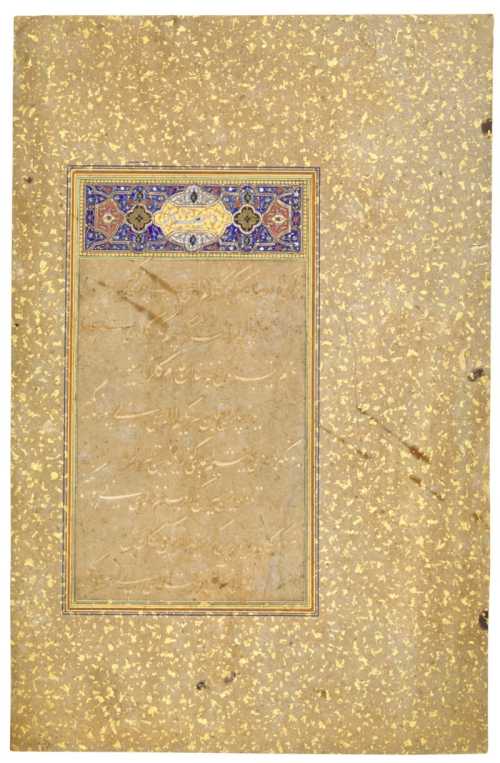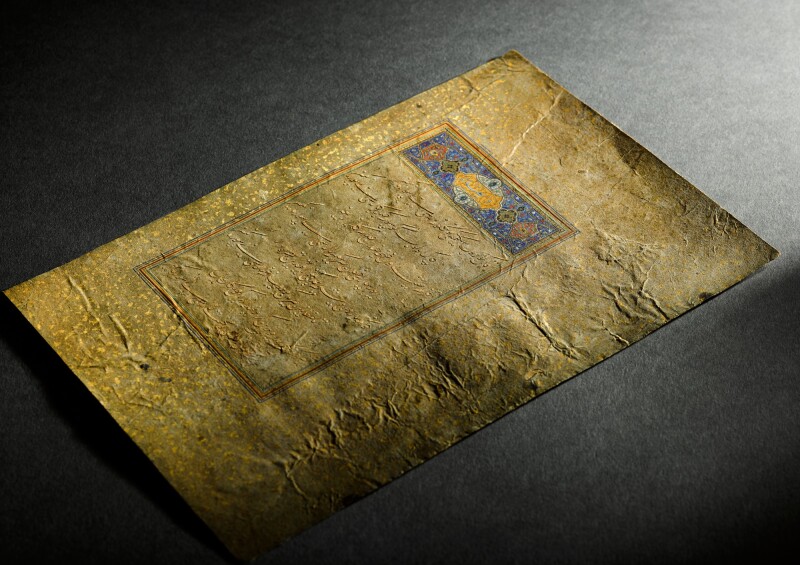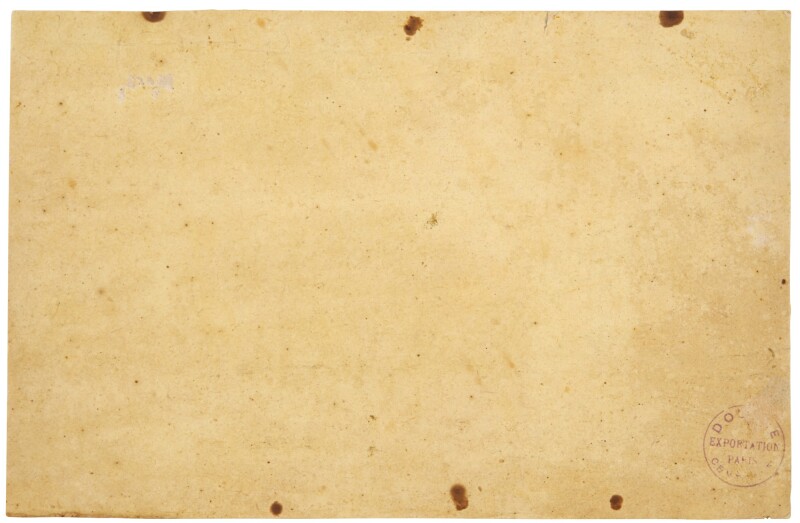- An illuminated page from a divan of Sultan Husayn Mirza Bayqara, with découpage nasta'liq calligraphy, Eastern Persia, Herat, circa 1490 1490
- Handicrafts and classics, Calligraphy, manuscript
- 14.4 * 22.6 cm
- Chagatay manuscript folio, opaque watercolour and gold on paper, 8 lines of fine nasta'iq découpage calligraphy against a pale green ground, illuminated heading panel with title in light blue nasta'liq, wide borders of gold-sprinkled pale green paperleaf: 22.6 by 14.4; text panel: 13.5 by 7.5cm.
Estimation
£10,000
13,089 USD
-
£15,000
19,634 USD
Realized Price
£18,900
24,738 USD
51.2%
Artwork Description
The manuscript from which this folio originates is one of the most remarkable examples of royal book production in the late medieval Islamic world. Throughout the entire manuscript the calligraphy is not written with a pen, as was the norm, but cut out from coloured paper (qit'a) and pasted onto the page. The technical virtuosity that this entails is extraordinary, and the general quality of the manuscript can be seen not only in the découpé calligraphy, but also in the exquisite illumination of the heading panels (as here), the opening double-page frontispiece (see Lentz and Lowry 1989, cat.148, p.268), and the elegant gold-sprinkled borders. In conception alone it is inspiringly ambitious, in execution it is superb. It has been suggested by Anthony Welch that Sultan Ali Mashhadi himself may have been the calligrapher responsible for this masterpiece (Geneva 1985, p.65).
The text is the Diwan of the Timurid prince and ruler of Herat, Sultan Husayn Mirza Bayqara (r.1470-1506), under whose patronage the arts of the book reached new heights in the last quarter of the fifteenth century. The School of Herat, among whose leading artists were the master Behzad and Sultan Ali Mashhadi, was the apotheosis and swan-song of Timurid art. Marie Lukens-Swietochowski has commented that "It is universally recognised that the reign of Mirza Sultan Husayn Ibn Mansur Ibn Bayqara Ibn Umar Shaykh Ibn Timur, patron par excellence in the tradition of his family, saw the last great flowering of Timurid art in Iran" (Gray et al 1979, p.179). Sultan Husayn was a literary enthusiast, patronising writers and poets such as Ali Shir Nava'i and Jami, and he wrote poetry himself, in Chagatay, using the pen-name Husayni. In this manuscript the ghazals are arranged alphabetically by their rhyme (Roxburgh 2005, p.170).
The manuscript is incomplete and dispersed in a number of collections around the world. The largest fragment is in the Museum of Turkish and Islamic Arts, Istanbul. Four pages are in the Los Angeles County Museum of Art, two are in the National Museum of Asian Art, Smithsonian Institution, Washington D.C., and others are in the Austrian National Library, the Library of Congress, Washington D.C., the Brooklyn Museum, the Aga Khan Museum, Toronto, and the Cincinnati Art Museum. Several of the folios in Western collections appear to have been on the market during the second quarter of the Twentieth century (e.g. the Freer Gallery pages were acquired in 1929, the LACMA pages were previously in the collection of Nasli Heeramaneck, the New York dealer/collector who was active from the 1920s to the middle of the century, and the folio in the Brooklyn Museum was acquired in 1945).
Two leaves, previously in the Stuart Cary Welch collection, were sold in these rooms, 6 April 2011, lots, 41 and 42. It is likely that Cary Welch acquired his folios from one of the New York dealers such as Minassian or Kevorkian. The current leaf has been backed on a page and bears a rubbed stamp which reads “DOUANE EXPORTATION PARIS CENTRALE”, indicating it had been exported from France probably in the middle of the Twentieth century.
Further discussion and references:
T. Lentz and G. Lowry, Timur and the Princely Vision, Los Angeles, 1989, cat. nos.148-149, pp.268-270, 359-360.
D. Roxburgh, The Persian Album 1400-1600, New Haven, 2005, fig.92, pp.170-1.
A. Sakisian, La Miniature Persane du XII au XVII siècle, Paris, 1929, fig.66, pl.XLI
T. Falk (ed.), Treasures of Islam, Geneva, 1985, no.35.
D. Duda, Die Illuminierten Handschriften Der Ossterreichischen Nationalbibliothek; Islamische Hanschriften I, Vienna, 1983, pl.368.
More lots by Unknown Artist
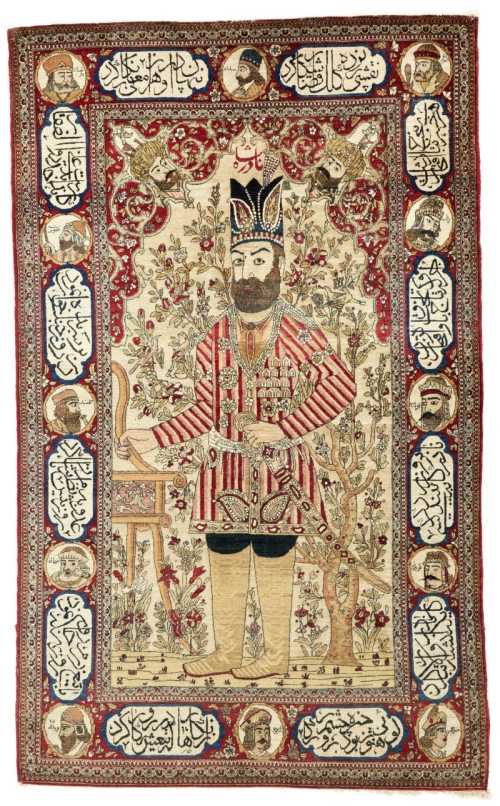
An Isfahan pictorial rug, Central Persia, circa 1910
Estimation
£4,000
5,236 USD
-
£6,000
7,853 USD
Realized Price
£5,670
7,421 USD
13.4%
Sale Date
Sotheby's
-
30 March 2022

A gold medal commemorating the coronation of Muhammad Reza Shah and Queen Farah
Estimation
£100
132 USD
-
£200
263 USD
Realized Price
£160
211 USD
6.667%
Sell at
Sale Date
Rosebery's Auction
-
1 April 2022
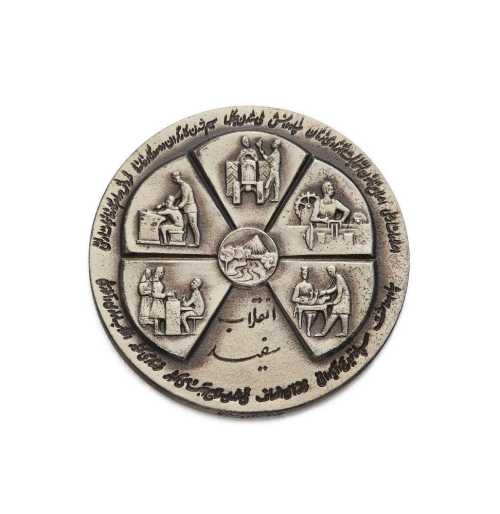
A silver memorial medal of the White Revolution, Muhammad Reza Shah, 1967
Estimation
£200
263 USD
-
£300
395 USD
Realized Price
£170
224 USD
32%
Sell at
Sale Date
Rosebery's Auction
-
1 April 2022
Realized Price
67,245 USD
Min Estimate
35,481 USD
Max Estimate
53,247 USD
Average Artwork Worth
+83.63%
Average Growth of Artwork Worth
Sales Performance Against Estimates
Average & Median Sold Lot Value
2021 - 2025
Performance vs. Estimate
2021 - 2025
Sell-through Rate
2021 - 2025
Similar Artworks
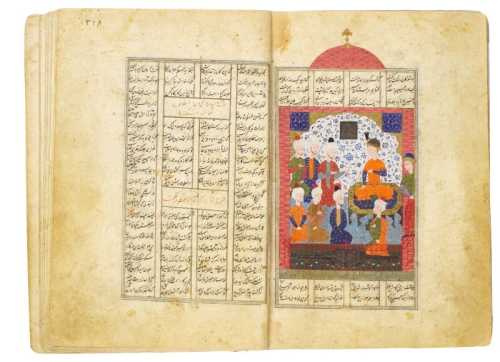
Nizami (d.1209), Khamsa, copied by Khwaja Mir ibn Shams al-Din Muhammad Munshi Astarabadi, Persia, Safavid, dated 966 AH/1558-9 AD
Estimation
£10,000
13,089 USD
-
£15,000
19,634 USD
Realized Price
£22,680
29,686 USD
81.44%
Sale Date
Sotheby's
-
30 March 2022
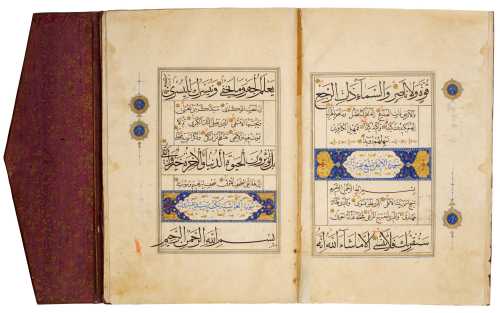
An illuminated Qur’an juz’ (XXX), copied by Muhammad ibn Hasan, known as Kamal, Persia, Safavid, dated 930 AH/1523-24 AD
Estimation
£15,000
19,634 USD
-
£20,000
26,178 USD
Realized Price
£18,900
24,738 USD
8%
Sale Date
Sotheby's
-
30 March 2022
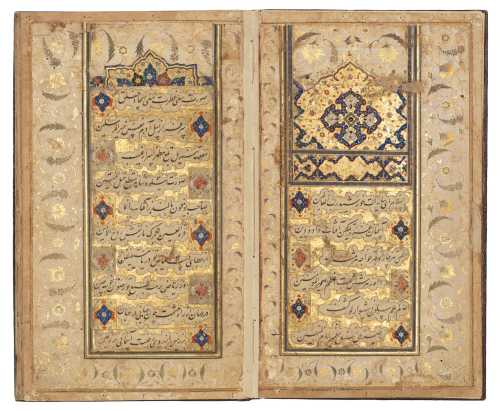
HASSAN KASHI: AFTAB INNAMA
Estimation
£6,000
7,897 USD
-
£8,000
10,529 USD
Realized Price
£16,380
21,558 USD
134%
Sell at
Sale Date
Christie's
-
31 March 2022
